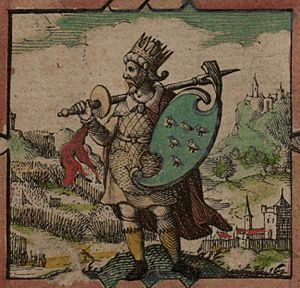Battle of Mercredesburne facts for kids
Quick facts for kids Battle of Mercredesburne |
|||||||
|---|---|---|---|---|---|---|---|
| Part of the Anglo-Saxon settlement of Britain | |||||||
|
|||||||
| Belligerents | |||||||
| South Britons | South Saxons | ||||||
| Commanders and leaders | |||||||
| Aurelius Ambrosius? | Ælle | ||||||
| Strength | |||||||
| Unknown | Unknown | ||||||
| Casualties and losses | |||||||
| Unknown | Unknown | ||||||
The Battle of Mercredesburne was an important fight in the early history of what is now England. It was one of three battles that helped create the Kingdom of Sussex in southern England. This battle happened between the army of the Saxon leader Ælle and the local people called Britons.
The Anglo-Saxon Chronicle is an old book that tells us about these events. It says that Ælle arrived in Sussex with three ships in 477 CE. He then fought at Cymenshore in 477, at Mercredesburne in 485, and at Pevensey in 491. Ælle became the first king of the South Saxons. Later, the Kingdom of Sussex became part of the Kingdom of Wessex in the 800s. Eventually, it became the county of Sussex, which you can find in England today.
Contents
What Led to the Battle?
The story of how the Kingdom of the South Saxons began comes from the Anglo-Saxon Chronicle. This book says that in 477, Ælle landed at a place called Cymenshore. He was with his three sons: Cymen, Wlenking, and Cissa.
The chronicle tells us that when they landed, Ælle's men fought the local people. They pushed the remaining Britons into the Forest of Andred. The book then describes Ælle's battle with the Britons in 485 near the Mercredesburne river. It also mentions his attack on Pevensey in 491.
A Possible Peace Treaty
Some historians, like Martin Welch, think that the Britons might have given land to the Anglo-Saxons. This land was between the Ouse and Cuckmere valleys in Sussex. They might have done this as part of a peace treaty.
Nennius, a Welsh monk from the 800s, wrote about a meeting. He said the British leader Vortigern met with the Anglo-Saxon leader Hengest. They wanted to make a treaty. Some believe that Vortigern was forced to agree to a treaty. This treaty might have given Sussex to the Anglo-Saxons. The name Mercredesburne might even mean "river of the frontier agreed by treaty." This idea supports the theory of a treaty.
The Battle of Mercredesburne
The Anglo-Saxon Chronicle from 485 states that Ælle fought a battle with the Britons at Mercredesburne. Other historians have added more details to this story. For example, Henry of Huntingdon, a historian from the 1100s, wrote about the battle. He suggested that neither side truly won the fight. He also said that both sides promised to be friends afterward. However, the Anglo-Saxons then asked for more soldiers from their homelands in Germany.
A chronicler from the 1300s, Roger of Wendover, even named the leader of the British forces. He said it was Aurelius Ambrosius.
Why It's Hard to Know the Full Story
It can be tricky for historians to know exactly what happened. The Anglo-Saxon Chronicle was written much later, about 400 years after these events. It was ordered by Alfred the Great.
At that time, the Anglo-Saxons mostly passed down stories by speaking them. They didn't write down many legal or historical events until they became Christians. This happened around the late 600s for the South Saxons. Early Christian writers probably got their information from spoken stories and poems. Later, medieval historians sometimes added more details to these stories. They did this to fit their own purposes.
What Happened After?
The Anglo-Saxon Chronicle doesn't say when Ælle died or who became king after him. But Henry of Huntingdon suggests that Ælle died in 515. He was the first king of Sussex. His son, Cissa, then became king.
Where Was the Battle Fought?
The exact place where the Battle of Mercredesburne happened is still a mystery.
Possible Locations
The villages of Ashburnham and Penhurst in East Sussex have a local story. They believe that an old earthwork, called Town Creep, was the battle site. This earthwork is in Creep Wood, near both villages.
Local stories from the 1800s said that Town Creep was once a town. This town was attacked and destroyed by the Saxons. In 1896, members of The Sussex Archaeological Society looked into this claim. They published a paper saying that Town Creep could be the site of the battle. They also thought that "Town Creep" might come from "Mercrede." The "burn" part of Mercredesburne might refer to the Ashburn stream nearby.
Another idea is that the battle was at modern Binstead. This is based on the old meaning of the name. It could mean "the sea landing stage at the watercress stream."
See also


